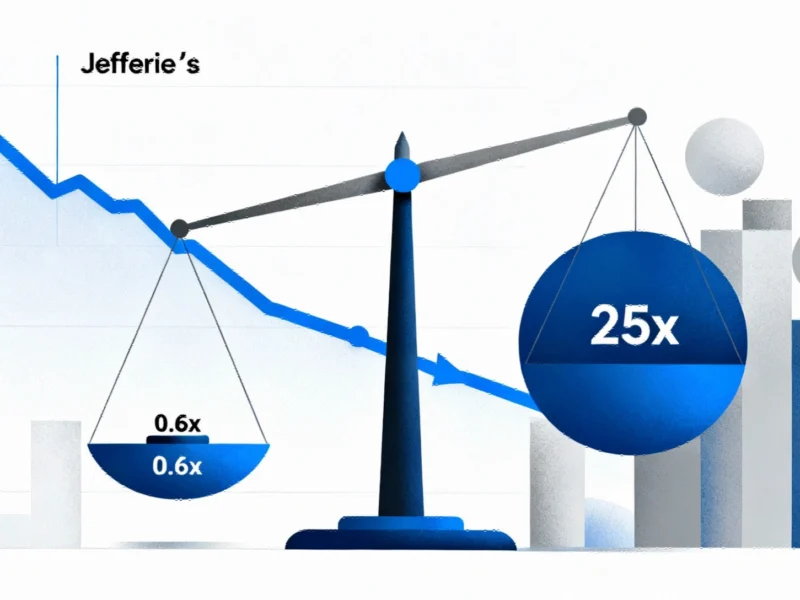According to Network World, Oracle’s massive data center expansion to support AI workloads could result in a $38 billion debt offering as soon as next week, with Morgan Stanley analysts projecting the total financing needs could skyrocket to $55-$75 billion due to the “sheer size of data center capex needs.” Industry analyst Sanchit Vir Gogia of Greyhound Research warns this represents a “profound change in Oracle’s capital posture” away from cash-funded growth toward debt structures similar to telecom infrastructure projects. The financing scale and rising credit default swap pricing signal increased execution risk that CIOs must now incorporate into vendor risk assessments. This dramatic shift in financing strategy raises critical questions about long-term stability for enterprises dependent on Oracle’s cloud ecosystem.
Table of Contents
From Software Giant to Infrastructure Behemoth
Oracle’s transformation represents one of the most dramatic business model pivots in enterprise technology history. For decades, Oracle Corporation built its dominance through high-margin software licensing and maintenance revenue, operating with minimal debt and substantial cash reserves. The shift to financing $75 billion in data center infrastructure through debt markets fundamentally alters the company’s risk profile. Unlike software development, which requires relatively modest capital investment, building global AI infrastructure at this scale demands telecom-level capital intensity with much longer payback periods. This creates a fundamentally different financial structure that enterprise customers must now evaluate alongside technical capabilities when making vendor decisions.
The Hidden Dependencies in Cloud Contracts
Enterprise technology leaders face a new dimension of vendor risk that extends far beyond service level agreements and technical performance. When a cloud provider carries massive debt loads to finance infrastructure, customers become indirectly exposed to capital market conditions, interest rate fluctuations, and creditor relationships. A company facing $75 billion in financing needs becomes highly sensitive to credit rating changes, which could impact their ability to continue infrastructure investments essential for maintaining competitive AI services. This creates what financial analysts call “duration risk” – the mismatch between long-term infrastructure investments and the shorter-term nature of cloud service contracts. Enterprises committing to multi-year Oracle cloud deals may find themselves tied to a provider whose financial flexibility becomes constrained by debt service requirements.
The AI Arms Race’s Financial Fallout
Oracle’s massive financing needs reflect the broader industry trend where cloud providers are racing to build AI infrastructure at unprecedented scale. However, the financing approach creates strategic differentiation. While competitors like Microsoft and Google have leveraged their massive cash reserves and diversified revenue streams to fund AI expansion, Oracle’s debt-heavy approach creates different pressure points. This financial strategy could force Oracle to prioritize high-margin AI services over broader cloud ecosystem development, potentially limiting innovation in other areas. The scale of investment also suggests Oracle is betting heavily on capturing AI market share quickly, creating an “all-in” scenario that leaves little room for strategic pivots if market demand doesn’t materialize as projected.
Navigating the New Vendor Risk Landscape
For enterprise technology leaders, this situation demands enhanced due diligence in vendor selection processes. Beyond evaluating technical capabilities and pricing, CIOs must now assess cloud providers’ capital structures, debt maturity profiles, and financing strategies. Companies should develop contingency plans for scenarios where heavily leveraged providers face financial constraints that could impact service quality or innovation roadmaps. This might include maintaining multi-cloud architectures specifically designed to mitigate concentration risk with any single heavily indebted provider. Additionally, contract negotiations should include stronger financial stability covenants and clearer exit provisions should a provider’s capital position deteriorate. The era where technical capabilities alone determined cloud vendor selection has ended – financial engineering now plays an equally crucial role in enterprise risk management.
The Coming Consolidation Wave
The massive capital requirements for AI infrastructure will inevitably reshape the cloud competitive landscape. Providers carrying substantial debt loads may face pressure to prioritize short-term revenue over long-term customer value, potentially creating opportunities for better-capitalized competitors. We’re likely to see increased industry consolidation as smaller players struggle to match the infrastructure investments required to remain competitive in AI services. For creditors and investors, the key question becomes whether the projected AI revenue growth can support the debt servicing costs of these massive infrastructure bets. The outcome will determine not just Oracle’s future, but the structure of the entire cloud computing industry for the next decade.



